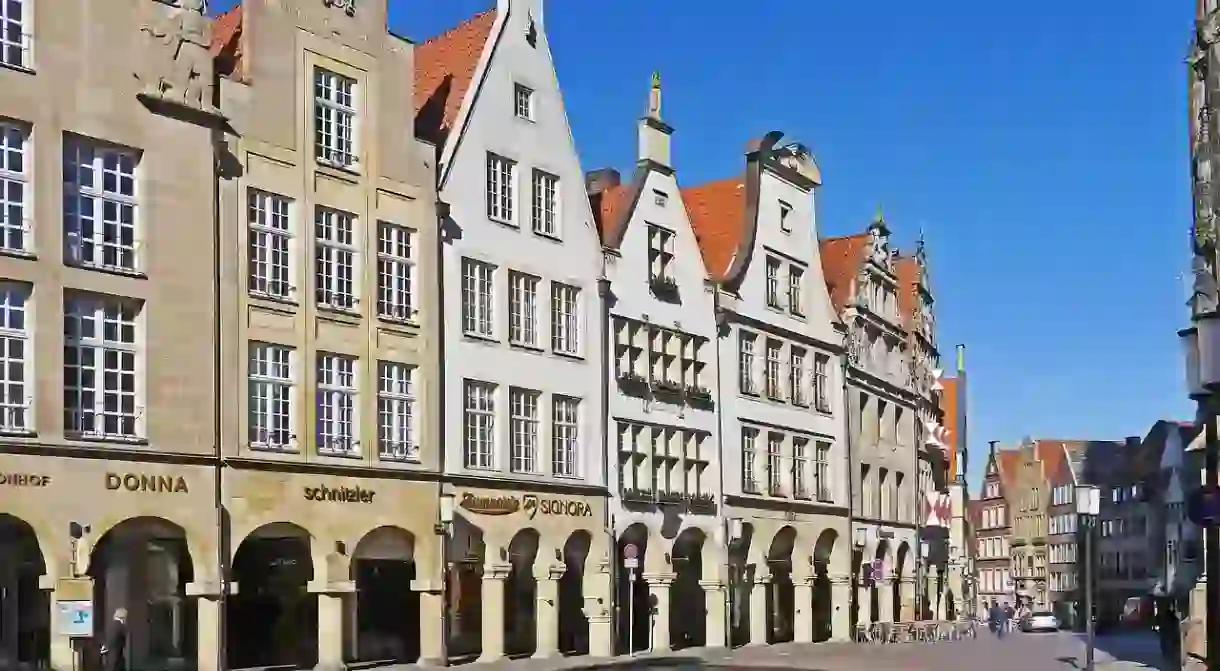How to Spend 24 Hours in Münster

Halfway between Cologne and Bremen lies the charming city of Münster. With a historic town centre and a youthful charm spread by the many university students, Münster bridges the gap between old and new. A day trip involves exploring historical sights and fantastic art galleries and lounging in hip eateries and bars in between. Here’s a 24-hour itinerary with all the highlights.
Morning
Before you get into sightseeing mode, get some breakfast and coffee to prepare for a jam-packed day. Being a university city certainly has its advantages – one of them being the large number of trendy cafés that a young crowd brings with it. You’ll be spoilt for choice when trying to choose a breakfast spot in the morning, since cute cafés are abundant in both the city centre and bordering neighbourhoods. You can’t go wrong whether you opt for fresh bagels at Teilchen & Beschleuniger, French pastries at Café Montmartre, avocado toast at Herr Sonnenschein or self-made poffertjes at Grotes.

Münster is very walkable, and the main attractions are only minutes from one another. Start your tour with the Catholic St Lamberti Church, a notable example of ecclesial Gothic architecture from the 14th century. If you tilt your head and glance up at the steeple, you’ll notice three iron cages hanging above the church clock. In the 1530s, the three remaining ringleaders of the Anabaptist Rebellion were publicly tortured and executed before their corpses were displayed in the cages to deter anyone from trying the same.
Turn a corner and follow the iconic Prinzipalmarkt. The street is lined with authentically reconstructed gabled houses and was once the commercial centre of Münster. Today, exclusive boutiques and restaurants occupy the historic townhouses and arcades on the city’s most popular strolling promenade. As you walk, the stunning sandstone arches and gables of Münster’s historic City Hall will catch your eye. In 1648, the City Hall was the scene of peace treaty negotiations which paved the way to the end of the Thirty Years’ War. The Friedenssaal (Hall of Peace) is decorated with intricate wood carvings throughout and can be visited for an entrance fee of just €2.

Next up is Münster’s most famous landmark. The twin towers of St Paul’s Cathedral soar high up into the sky and overlook the vast plaza out front. Construction began in 1225, and it’s worth taking some time to marvel at the beautiful façade and the imposing westwork. The inside is no less spectacular – you’ll be greeted by a statue of Saint Christopher, the patron saint of travellers, at the main gate, and be wowed by murals, the prominent choir and an astronomical clock from the 16th century. With a bit of luck, you will get here just before midday when the carillon starts up.
Afternoon
Grab a quick lunch before continuing your tour. You can get healthy salads, wraps and sandwiches at the popular chain Dean & David, fast-yet-quality Italian food at Vapiano or yummy vegan bowls at Krawummel, which are all nearby.
Refuelled, make your way to the Picasso Museum (€10). The 18th-century building houses a collection of more than 800 of the artist’s lithographs, and constantly changing temporary exhibitions display some of the most notable artworks by Picasso himself and his friends and peers. Public tours run on Saturday and Sunday for an extra charge of €6, though tours in a language other than German need to be requested in advance.

Given that Münster is Germany’s bicycle capital, it’d be silly not to make some time to cruise around town on two wheels. The Radstation Münster Arkaden bike rental shop is right next door to the Picasso Museum, and you can get a bike for as €8 a day. Take your bike down south to the outskirts and around the idyllic Lake Aa. The vast parklands are home to various museums, art installations and cafés. If the weather plays along, the reservoir is a great spot for a picnic, paddleboat tour or a sunbathing session.
Evening
Back in town, pick your dinner locale. If you fancy some good old Westphalian specialities à la salted pork leg and Mettenden soup, you’re in luck. Münster has a number of cute and cosy traditional restaurants from which to choose. Münster’s oldest inn, Altes Gasthaus Leve, dates back to 1607 and boasts a long menu of hearty German dishes. The interior is dimly lit, wooden beams cover the ceilings, and parts of the walls are decorated in hand-painted tiles. Pinkus is the only remaining Altbier brewhouse in the city and serves traditional food alongside its cold draft beers. German food is also the focus at Druebbelken, a rustic restaurant with seasonally changing menus. If all those options don’t speak to you and you crave something lighter and perhaps less meat-heavy, you can always head to one of the international or even vegan-only restaurants that are scattered all over town.

Finish your day by diving into the bar scene. As we’ve mentioned early, Münster is a vibrant university city, and so it’s not much of a surprise that you’ll find some pretty hip bars, pubs and clubs here. Your best bet is to head to the Hafenviertel neighbourhood and just go with the flow. The streets here are lined with hotspots, such as the Watusi-Bar, Bohème Boulette and the Hot Jazz club, which make for a great night out before you say goodbye to Münster.













